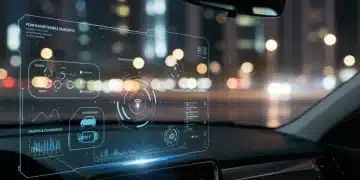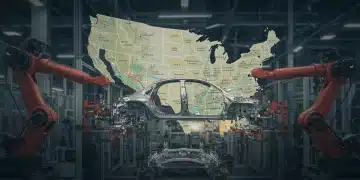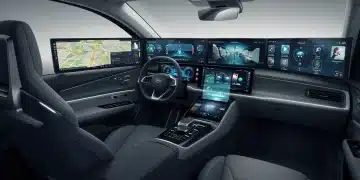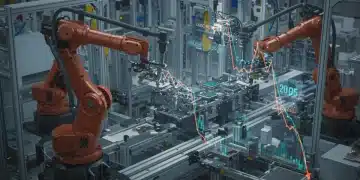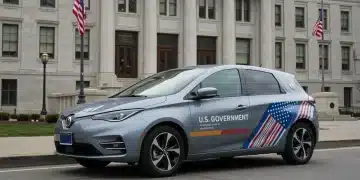OTA Updates: US Automakers Delivering New Features in 2025
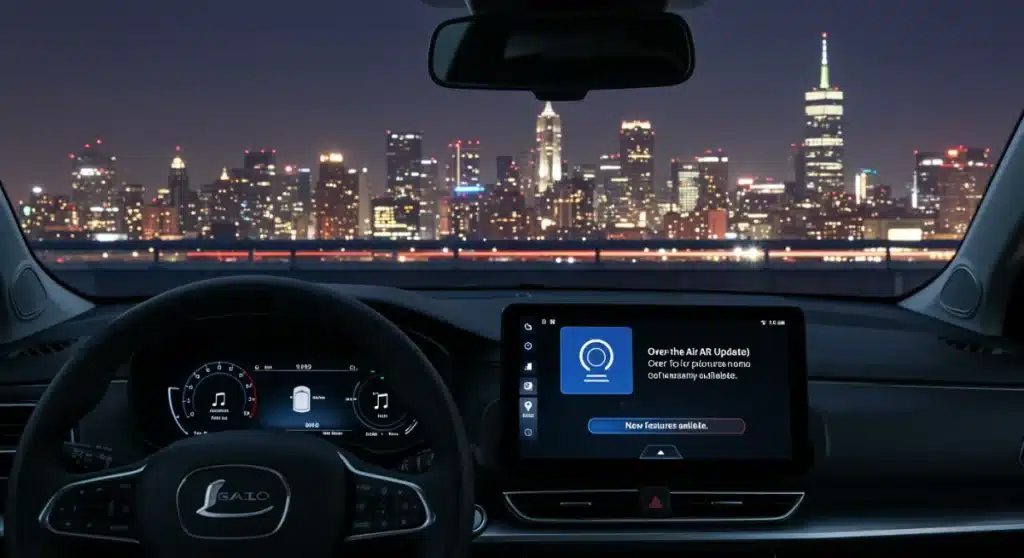
The automotive industry is undergoing a profound transformation, with The Rise of Over-the-Air (OTA) Updates: How US Automakers are Delivering New Features in 2025 emerging as a pivotal trend. By 2025, American car manufacturers are set to redefine vehicle ownership, moving beyond traditional hardware cycles to a dynamic, software-driven model that continuously enhances vehicle capabilities and user experience.
The Strategic Shift Towards Software-Defined Vehicles
US automakers are strategically pivoting towards software-defined vehicles, a move that places software and connectivity at the core of vehicle design and functionality. This fundamental shift allows for unprecedented flexibility and responsiveness, enabling vehicles to evolve long after they leave the factory floor.
This evolving paradigm means that a car purchased today can receive significant upgrades and entirely new features tomorrow, purely through remote software installations. This capability not only extends the lifecycle of a vehicle but also promises to keep it technologically current with rapidly advancing innovations.
Redefining Automotive Innovation
The ability to update vehicles remotely redefines the pace and scope of automotive innovation. Instead of waiting for new model years, consumers can expect a continuous stream of enhancements.
- Faster Feature Deployment: New functionalities, from advanced driver-assistance systems (ADAS) to infotainment upgrades, can be rolled out swiftly.
- Enhanced Performance: Engine management, battery optimization, and other critical systems can be refined for better efficiency and power.
- Personalized Experiences: Customization options and user interfaces can be tailored to individual preferences post-purchase.
Key Players and Their OTA Strategies
Major US automakers are heavily investing in robust OTA infrastructure and development. Companies like Tesla have long championed OTA, setting a precedent for the industry, while Ford and General Motors are rapidly catching up, integrating sophisticated software platforms into their latest vehicle architectures.
These companies are not just deploying bug fixes; they are delivering substantial upgrades that impact everything from driving dynamics to interior cabin features. This aggressive adoption is a clear indicator of the competitive landscape, where software prowess is becoming as critical as hardware engineering.
Ford’s Power-Up and GM’s Ultifi Initiatives
Ford’s ‘Ford Power-Up’ updates, for instance, have already delivered significant new features and performance enhancements to vehicles like the F-150 and Mustang Mach-E. These updates range from new gaming experiences to hands-free driving capabilities. General Motors, with its ‘Ultifi’ software platform, aims to provide a similar level of continuous improvement and personalization across its diverse portfolio.
These platforms are designed to be scalable and secure, ensuring that updates are delivered efficiently and without compromising vehicle safety or data privacy. The focus is on creating a seamless and integrated experience for the end-user, making the update process largely invisible and hassle-free.
Benefits for Consumers and Automakers
The advantages of OTA updates are multi-faceted, benefiting both vehicle owners and the manufacturers themselves. For consumers, the promise of an ever-improving vehicle is a significant draw, offering enhanced value and a more dynamic ownership experience.
Automakers, on the other hand, gain invaluable flexibility. They can respond quickly to market demands, address potential issues more efficiently, and even unlock new revenue streams through subscription-based features or one-time upgrades. This shifts the relationship with the customer from a transactional one at the point of sale to an ongoing, service-oriented engagement.
Driving Customer Satisfaction and Loyalty
- Increased Safety: Critical safety updates and recalls can be deployed rapidly, often preventing the need for dealership visits.
- Cost Savings: Reduced need for physical recalls and service appointments saves both manufacturers and consumers time and money.
- New Revenue Opportunities: Automakers can offer premium features or services on a subscription basis, creating recurring income.
- Enhanced Resale Value: A continuously updated vehicle maintains its technological relevance, potentially boosting its resale value.
Technological Foundations and Challenges
Implementing widespread OTA capabilities requires a robust technological foundation. This includes secure, high-bandwidth connectivity, sophisticated software architecture within the vehicle, and advanced back-end infrastructure for managing and deploying updates. Cybersecurity is paramount, as any vulnerability in the OTA process could have severe consequences.
Challenges also include managing the complexity of diverse vehicle models and generations, ensuring compatibility, and addressing consumer concerns about data privacy and the potential for unauthorized access. Automakers are investing heavily in encryption, secure boot processes, and rigorous testing protocols to mitigate these risks.

Ensuring Security and Reliability
The integrity of OTA updates hinges on uncompromised security. Manufacturers are employing multi-layered security protocols to protect against cyber threats.
- End-to-End Encryption: All data transmitted during an update is encrypted to prevent interception and tampering.
- Secure Boot Mechanisms: Vehicles are designed to verify the authenticity of software updates before installation, preventing malicious code from running.
- Over-The-Air Provisioning: Secure credential management ensures that only authorized updates are installed.
Reliability is another critical factor. Updates must be robust enough to handle unexpected interruptions, such as loss of signal, and capable of rolling back safely if an issue arises. This requires sophisticated software design and extensive real-world testing.
Regulatory Landscape and Industry Standards
As OTA updates become standard, regulatory bodies are beginning to address the implications for vehicle safety, emissions, and consumer rights. Standards are evolving to ensure that these updates are safe, transparent, and do not inadvertently compromise vehicle integrity or regulatory compliance.
Discussions are ongoing regarding liability in the event of an issue caused by an OTA update, as well as the need for clear communication with consumers about what updates entail. US automakers are actively engaging with regulators to help shape these emerging frameworks, aiming for a balance between innovation and public safety.
Navigating New Legal and Ethical Questions
The rapid pace of OTA deployment introduces new legal and ethical considerations. Questions surrounding data ownership, the right to repair, and the long-term implications of software-controlled vehicles are becoming increasingly prominent.
For instance, who owns the data generated by a connected car, and how can it be used? What happens if an OTA update disables a feature a consumer paid for? These are complex issues that require careful consideration and collaboration between industry, government, and consumer advocacy groups.
The Future of Vehicle Ownership: 2025 and Beyond
By 2025, OTA updates will not just be a convenience but a fundamental expectation for new vehicle buyers in the US. The ability to refresh and enhance a car’s capabilities remotely will fundamentally alter the concept of vehicle ownership, making cars more akin to smartphones on wheels—constantly evolving and adapting.
This trajectory suggests a future where vehicles become personalized, intelligent platforms, offering services and experiences that are unimaginable with today’s static hardware. The competitive edge will increasingly belong to automakers that can master this software-driven ecosystem, delivering seamless, secure, and value-adding updates.
Anticipated Advancements and Consumer Expectations
Looking beyond 2025, consumers can expect even more sophisticated OTA capabilities. This includes highly personalized driving profiles, predictive maintenance features that anticipate issues before they occur, and seamless integration with smart home and city infrastructure. The vehicle will become a more integral part of a connected lifestyle, offering a continuous stream of new possibilities.
The demand for these evolving features will push automakers to innovate further, fostering a dynamic cycle of development and deployment. The traditional dealership model may also transform, with a greater emphasis on software support and experiential showcases rather than just sales of static hardware.
| Key Point | Brief Description |
|---|---|
| Software-Defined Vehicles | US automakers are prioritizing software and connectivity for continuous vehicle evolution and new feature delivery. |
| Major Automaker Adoption | Companies like Ford and GM are heavily investing in OTA platforms, following Tesla’s pioneering lead. |
| Consumer & Manufacturer Benefits | OTA offers enhanced safety, cost savings, new revenue streams, and improved customer satisfaction. |
| Security and Regulations | Robust cybersecurity and evolving regulatory frameworks are crucial for secure and compliant OTA deployment. |
Frequently Asked Questions About OTA Updates
OTA updates are remote software upgrades delivered directly to a vehicle’s embedded systems, typically via cellular or Wi-Fi connections. They enable manufacturers to add new features, improve performance, and fix bugs without requiring a physical visit to a service center.
Tesla has long been a pioneer, but traditional US automakers like Ford with its ‘Power-Up’ and General Motors with ‘Ultifi’ are rapidly advancing their OTA capabilities. These companies are investing heavily to integrate comprehensive software platforms into their vehicle lines.
OTA updates can deliver a wide range of features, including advanced driver-assistance systems (ADAS) enhancements, infotainment system upgrades, performance optimizations for powertrain and battery, new user interface elements, and even entirely new functionalities like hands-free driving modes.
Automakers prioritize security for OTA updates, employing end-to-end encryption, secure boot mechanisms, and rigorous testing. The goal is to ensure that only authorized, verified software is installed, protecting against cyber threats and maintaining vehicle integrity and safety.
OTA updates will transform vehicles into continuously improving, software-defined platforms. Owners can expect their cars to gain new capabilities and stay technologically current over time, enhancing resale value and fostering a more dynamic, personalized ownership experience akin to modern smart devices.
Looking Ahead
This accelerating shift toward OTA updates by US automakers signals a fundamental redefinition of the automotive product lifecycle. What happens next involves not just technological refinement but also significant shifts in business models, regulatory frameworks, and consumer expectations. We will likely see further integration of vehicles into broader digital ecosystems, with cars becoming personalized, intelligent hubs. The industry will continue to navigate complex challenges around cybersecurity, data privacy, and the evolving legal landscape, all while striving to deliver an increasingly connected and capable driving experience.
